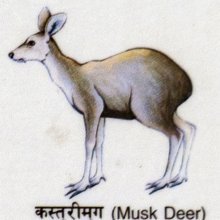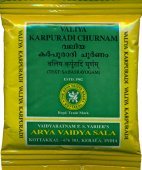Kasturi, Kastūrī, Kastūri: 23 definitions
Introduction:
Kasturi means something in Hinduism, Sanskrit, the history of ancient India, Marathi, Hindi, biology, Tamil. If you want to know the exact meaning, history, etymology or English translation of this term then check out the descriptions on this page. Add your comment or reference to a book if you want to contribute to this summary article.
Images (photo gallery)
In Hinduism
Ayurveda (science of life)
Rasashastra (Alchemy and Herbo-Mineral preparations)
Source: Wisdom Library: Rasa-śāstraKastūrī (कस्तूरी) refers to “musk”. It is used in Ayurvedic literature such as the Rasaprakāśasudhākara (Sanskrit book on rasaśāstra, or ‘Indian medicinal alchemy’).
Dietetics and Culinary Art (such as household cooking)
Source: Shodhganga: Dietetics and culinary art in ancient and medieval IndiaKastūri (कस्तूरि) refers to “musk” and is mentioned as one of the fruits used in the treatment of aggravated phlegm, according to the 17th century Bhojanakutūhala (dravyaguṇāguṇa-kathana), and is commonly found in literature dealing with the topics of dietetics and culinary art, also known as Pākaśāstra or Pākakalā.—Procedure to alleviate kapha (phlegm) after meals: The excess phlegm in the human body can lead to the weakening of digestive fire. Sleeping immediately after the meal will result in the aggravation of phlegm. The excess phlegm must be alleviated by employing fumes of the fragrant substances or consuming fruits [like kastūri (musk), ...]. After a meal, one must walk a few steps. Practising this lightens the food mass and imparts comfort in the neck, knees and loins. [...]

Āyurveda (आयुर्वेद, ayurveda) is a branch of Indian science dealing with medicine, herbalism, taxology, anatomy, surgery, alchemy and related topics. Traditional practice of Āyurveda in ancient India dates back to at least the first millenium BC. Literature is commonly written in Sanskrit using various poetic metres.
Pancaratra (worship of Nārāyaṇa)
Source: Shodhganga: Temples and cult of Sri Rama in Tamilnadu (pancaratra)Kasturi (musk) refers to one of the various items used during the holy bath, as prescribed in Pancaratra literature in the Tamil tradition.—[Kasturi or Musk is usually placed on the forehead as tilaka before the pundra is applied]—Tirumanjanam or abhishekam or “the holy bath” is a picturesque ceremony in a Vishnu temple and forms an essential daily item in the worship. [...] Various items are used for bathing the deity [viz., kasturi], etc. After the bath is over, the images are dried with cloth and dressed with fine clothes and bedecked with ornaments and fresh garlands. A salad, with a mixture of fruits, coconut, honey (panchamirtham) and lemon juice (panagam) and betels, are offered to the deity and later distributed to the devotees.

Pancaratra (पाञ्चरात्र, pāñcarātra) represents a tradition of Hinduism where Narayana is revered and worshipped. Closeley related to Vaishnavism, the Pancaratra literature includes various Agamas and tantras incorporating many Vaishnava philosophies.
Shaivism (Shaiva philosophy)
Source: Brill: Śaivism and the Tantric TraditionsKastūrī (कस्तूरी) refers to “musk”, according to the 13th-century Matsyendrasaṃhitā: a Kubjikā-Tripurā oriented Tantric Yoga text of the Ṣaḍanvayaśāmbhava tradition from South India.—Accordingly, “[Visualisation of Śakti]:—[...] The tilaka-mark on her forehead is made with musk (kastūrī) thickened with camphor. She has lotus-eyes. She is adorned with rings, armlets, anklets, necklaces etc. Her beautiful lotus face resembles the spotless moon. Her mouth is filled with betel. Her breasts are like golden jars. [...]”.
Source: SOAS University of London: Protective Rites in the Netra TantraKastūrī (कस्तूरी) is the name of a Devī associated with Viṣṇu, according to the Netratantra of Kṣemarāja: a Śaiva text from the 9th century in which Śiva (Bhairava) teaches Pārvatī topics such as metaphysics, cosmology, and soteriology.—Accordingly, [verse 13.1-9, while describing the appearance and worship of Viṣṇu]—“Or, [the Mantrin] worships a very handsome, eight-armed, yellow Deva. [...] The goddesses Karpūrī, Candanī, Kastūrī, and Kuṅkumī stand at the cardinal directions, and have a similar form as the Deva. The Devīs grant the fruits of the desired siddhis. What more should be said here? [...]”.

Shaiva (शैव, śaiva) or Shaivism (śaivism) represents a tradition of Hinduism worshiping Shiva as the supreme being. Closely related to Shaktism, Shaiva literature includes a range of scriptures, including Tantras, while the root of this tradition may be traced back to the ancient Vedas.
Purana and Itihasa (epic history)
Source: archive.org: Shiva Purana - English TranslationKastūrī (कस्तूरी) refers to “musk” (suitable for a festival ceremony), according to the Śivapurāṇa 2.3.30 (“The Celebration of Pārvatī’s Return”).—Accordingly, as Brahmā narrated to Nārada: “On hearing that Pārvatī was returning, Menā and Himavat excessively delighted went ahead seated in a divine vehicle. [...] The auspicious water-pot was placed in the main highway decorated with sandal paste, aguru, musk (kastūrī) and branches of trees with fruits. The priests, Brahmins and sages reciting the Vedas, dancing girls, all went ahead seated on lofty elephants to receive her. All round stumps of plantain trees were fixed. [...]”.

The Purana (पुराण, purāṇas) refers to Sanskrit literature preserving ancient India’s vast cultural history, including historical legends, religious ceremonies, various arts and sciences. The eighteen mahapuranas total over 400,000 shlokas (metrical couplets) and date to at least several centuries BCE.
Sports, Arts and Entertainment (wordly enjoyments)
Source: archive.org: Syainika Sastra of Rudradeva with English Translation (art)1) Kastūri (कस्तूरि) refers to “musk” (which was commonly collected by hunters), according to the Śyainika-śāstra: a Sanskrit treatise dealing with the divisions and benefits of Hunting and Hawking, written by Rājā Rudradeva (or Candradeva) in possibly the 13th century.—Accordingly, “Hunting on horseback (āśvina) represents one of the eight subdivisions of Hunting (mṛgayā). [...] It leads to the acquisition of wealth by the capture of wild elephants and rhinoceros, by collecting horns and hides, musk (kastūri) and precious stones, feathers and such like things. [...]”.
2) Kastūrī (कस्तूरी) or “musk” is used to combat parasites eating the Hawk’s feathers, according to the Śyainika-śāstra.—Accordingly, [while discussing the treatment of hawks]: “[...] If parasites eat off the feathers, the remedy is equal quantities of Viḍaṅga, marking nut, and musk (kastūrī); or, in the case of fat birds two ratis of rock-salt with meat for three days, but for lean birds only half a rati of rock-salt. [...]”.

This section covers the skills and profiencies of the Kalas (“performing arts”) and Shastras (“sciences”) involving ancient Indian traditions of sports, games, arts, entertainment, love-making and other means of wordly enjoyments. Traditionally these topics were dealt with in Sanskrit treatises explaing the philosophy and the justification of enjoying the pleasures of the senses.
India history and geography
Source: Project Gutenberg: Castes and Tribes of Southern India, Volume 1Kasturi (“musk”) is one of the exogamous septs (divisions) among the Kammas (agriculturists and traders). The word Kamma in Telugu means the ear-ornament, such as is worn by women. The Razus, who now claim to be Kshatriyas, were probably descended from Kapus, Kammas, and Velamas.

The history of India traces the identification of countries, villages, towns and other regions of India, as well as mythology, zoology, royal dynasties, rulers, tribes, local festivities and traditions and regional languages. Ancient India enjoyed religious freedom and encourages the path of Dharma, a concept common to Buddhism, Hinduism, and Jainism.
Biology (plants and animals)
Source: Wisdom Library: Local Names of Plants and DrugsKasturi [কস্তূৰী] in the Bengali language is the name of a plant identified with Quassia amara from the Simaroubaceae (Quassia) family. For the possible medicinal usage of kasturi, you can check this page for potential sources and references, although be aware that any some or none of the side-effects may not be mentioned here, wether they be harmful or beneficial to health.
Kasturi [கஸ்தூரி] in the Tamil language is the name of a plant identified with Vachellia farnesiana (L.) Wight & Arn. from the Mimosaceae (Touch-me-not) family having the following synonyms: Acacia acicularis, Acacia farnesiana, Mimosa farnesiana.
Source: Google Books: CRC World Dictionary (Regional names)1) Kasturi in India is the name of a plant defined with Delphinium brunonianum in various botanical sources. This page contains potential references in Ayurveda, modern medicine, and other folk traditions or local practices.
2) Kasturi is also identified with Citrus medica It has the synonym Sarcodactilis helicteroides Gaertn. (etc.).
3) Kasturi in Indonesia is also identified with Abelmoschus moschatus It has the synonym Hibiscus collinsianus Nutt. ex Torr. & A. Gray (etc.).
Example references for further research on medicinal uses or toxicity (see latin names for full list):
· Royle, John Forbes (1798–1858), (1798)
· Ueber einige kunstliche Geschlecter aus der Malven-Familie (1787)
· The Flora of British India (1875)
· Prodromus Stirpium in Horto ad Chapel Allerton vigentium (1796)
· Hortus Bengalensis (1814)
· Illustrations of the botany and other branches of the natural history of the Himalayan Mountains
If you are looking for specific details regarding Kasturi, for example diet and recipes, pregnancy safety, chemical composition, extract dosage, health benefits, side effects, have a look at these references.

This sections includes definitions from the five kingdoms of living things: Animals, Plants, Fungi, Protists and Monera. It will include both the official binomial nomenclature (scientific names usually in Latin) as well as regional spellings and variants.
Languages of India and abroad
Marathi-English dictionary
Source: DDSA: The Molesworth Marathi and English Dictionarykastūrī (कस्तूरी).—f (S) pop. kasturī f Musk. 2 A term for a black ṭikalā.
Source: DDSA: The Aryabhusan school dictionary, Marathi-Englishkasturī (कस्तुरी).—f Musk. kastūrīmṛga m The musk-deer.
--- OR ---
kastūrī (कस्तूरी).—f Musk. kastūrīmṛga m The musk-deer.
Marathi is an Indo-European language having over 70 million native speakers people in (predominantly) Maharashtra India. Marathi, like many other Indo-Aryan languages, evolved from early forms of Prakrit, which itself is a subset of Sanskrit, one of the most ancient languages of the world.
Sanskrit dictionary
Source: DDSA: The practical Sanskrit-English dictionaryKastūrī (कस्तूरी).—Musk; कस्तूरिकातिलकमालि विधाय सायम् (kastūrikātilakamāli vidhāya sāyam) Bv.2.4;1.121; Ch. P.7.
See also (synonyms): kasturikā.
Source: Cologne Digital Sanskrit Dictionaries: Shabda-Sagara Sanskrit-English DictionaryKastūrī (कस्तूरी).—f. (-rī) 1. Musk, the animal perfume so called, as brought from Kashmir, Napal, and western Asam or Bhutan, the latter is said to be the best. 2. A plant, (Hibiscus abelmoschus.) 3. Another plant, (Amaryllis zeylanica.) E. kas to go, and tūrac affix; its scent going or spreading; the deriv. is irr.; also kan being added kastūrikā and kasturikā as above.
Source: Cologne Digital Sanskrit Dictionaries: Cappeller Sanskrit-English DictionaryKastūrī (कस्तूरी).—[feminine] musk.
Source: Cologne Digital Sanskrit Dictionaries: Aufrecht Catalogus CatalogorumKastūri (कस्तूरि) as mentioned in Aufrecht’s Catalogus Catalogorum:—son of Nāgaya: Kastūrismṛti or Smṛtiśekhara.
Source: Cologne Digital Sanskrit Dictionaries: Monier-Williams Sanskrit-English Dictionary1) Kastūri (कस्तूरि):—m. Name of the author of a law-book.
2) Kastūrī (कस्तूरी):—[from kastūrikā] f. musk, [Sāhitya-darpaṇa 337, 3; Bhāvaprakāśa] etc.
3) [v.s. ...] the plant Hibiscus Abelmoschus, [cf. Lexicographers, esp. such as amarasiṃha, halāyudha, hemacandra, etc.]
4) [v.s. ...] the plant Amaryllis zeylanica, [cf. Lexicographers, esp. such as amarasiṃha, halāyudha, hemacandra, etc.]
Source: Cologne Digital Sanskrit Dictionaries: Yates Sanskrit-English DictionaryKastūrī (कस्तूरी):—(rī) 3. f. Idem; a plant.
Source: DDSA: Paia-sadda-mahannavo; a comprehensive Prakrit Hindi dictionary (S)Kastūrī (कस्तूरी) in the Sanskrit language is related to the Prakrit words: Katthūriyā, Katthūrī.
[Sanskrit to German]
Sanskrit, also spelled संस्कृतम् (saṃskṛtam), is an ancient language of India commonly seen as the grandmother of the Indo-European language family (even English!). Closely allied with Prakrit and Pali, Sanskrit is more exhaustive in both grammar and terms and has the most extensive collection of literature in the world, greatly surpassing its sister-languages Greek and Latin.
Hindi dictionary
Source: DDSA: A practical Hindi-English dictionaryKastūrī (कस्तूरी):—(nf) musk; —[mṛga] a musk-deer.
...
Kannada-English dictionary
Source: Alar: Kannada-English corpusKasturi (ಕಸ್ತುರಿ):—[noun] = ಕಸ್ತೂರಿ - [kasturi -] 1.
--- OR ---
Kastūri (ಕಸ್ತೂರಿ):—
1) [noun] a substance with a strong, penetrating odour, obtained from a small sac (musk bag) under the skin of the abdomen in the male musk deer; musk.
2) [noun] a subsect among agricultural community.
3) [noun] the plant Delphinium brunonianum of Ranunculaceae family.
Kannada is a Dravidian language (as opposed to the Indo-European language family) mainly spoken in the southwestern region of India.
Tamil dictionary
Source: DDSA: University of Madras: Tamil LexiconKastūri (கஸ்தூரி) noun < kastūrī.
1. Musk, animal perfume supposed to come out of the navel of the musk deer, of which there are five kinds, viz., கரிகை, திலகை, குளுந்தை, பிண்டகை, நாயகை; கஸ்தூரிமானின் நாபியினின்று எடுக்கப் படும் வாசனைப்பொருள். [yapparungalag karigai, thilagai, kulunthai, pindagai, nayagai; kasthurimanin napiyininru edukkap padum vasanaipporul.] (பதார்த்தகுண சிந்தாமணிமேகலை [patharthaguna sindamani] 1081.)
2. See கஸ்தூரிமான். [kasthuriman.]
--- OR ---
Kastūri (கஸ்தூரி) noun
1. A kind of tree, medium tree, Acacia farnesiana; வேலமரவகை. [velamaravagai.] (Nels.)
2. A kind of saree; சேலைவகை. கஸ்தூரிமடி. [selaivagai. kasthurimadi.]
3. Ass's milk; கழுதைப்பால். [kazhuthaippal.] Madras usage
Tamil is an ancient language of India from the Dravidian family spoken by roughly 250 million people mainly in southern India and Sri Lanka.
See also (Relevant definitions)
Starts with (+51): Kasturi bende, Kasturi mallige, Kasturi manjal, Kasturi methi, Kasturi roriha, Kasturi tuma, Kasturi-benda-vittulu, Kasturi-bhenda, Kasturi-bhendo, Kasturi-dana, Kasturi-gobli, Kasturi-jali-mara, Kasturi-kamal, Kasturi-koticelai, Kasturi-mallikai, Kasturi-paspu, Kasturi-pata, Kasturi-salak, Kasturi-vendaik-kay-virai, Kasturi-venta-vitta.
Ends with (+12): Bhojanakasturi, Bilikamakasturi, Kaama kasturi, Kaama-kasturi, Kaamakasturi, Kaattu kasturi, Kaattu-kasturi, Kadukasturi, Kalakasturi, Kalikasturi, Kalkasturi, Kam kasturi, Kama kasturi, Kama-kasturi, Kamakasturi, Kamkasturi, Karikasturi, Kattakasturi, Kattu-kasturi, Kattuk-kasturi.
Full-text (+95): Kasturika, Kalakasturi, Kasturismriti, Smritishekhara, Kasturimallika, Kattu-kasturi, Kasturimriga, Kadukasturi, Kasturi-dana, Kasturi-venta-vitta, Kasturi-koticelai, Kasturi-mallikai, Kuluntai, Latakasturi, Kasthoori pushpa, Kasthoori benda, Kasthoori, Latha kasthoori, Kaama kasthoori, Kasthoori bende.
Relevant text
Search found 33 books and stories containing Kasturi, Kastūrī, Kastūri, Kasturī, Kasthuri, Kasthoori, Kasduri, Kasdhuri; (plurals include: Kasturis, Kastūrīs, Kastūris, Kasturīs, Kasthuris, Kasthooris, Kasduris, Kasdhuris). You can also click to the full overview containing English textual excerpts. Below are direct links for the most relevant articles:
Amarakoshodghatana of Kshirasvamin (study) (by A. Yamuna Devi)
Daily Life (3): Perfumes < [Chapter 3 - Social Aspects]
Cosmetics, Costumes and Ornaments in Ancient India (by Remadevi. O.)
1.9. Use of Kastūrī (Musk) < [Chapter 1 - Cosmetics]
1. Materials for Cosmetics (Introduction) < [Chapter 1 - Cosmetics]
2.11. Pharmaceutical use of Incense < [Chapter 1 - Cosmetics]
Garga Samhita (English) (by Danavir Goswami)
Verse 2.21.39 < [Chapter 21 - The Rāsa-dance Pastime]
Verse 4.12.14 < [Chapter 12 - The Story of the Gopīs That In the Holi Festival Displayed Three Transcendental Virtues]
Verses 5.7.16-17 < [Chapter 7 - The Killing of Kuvalayāpīḍa]
Chaitanya Bhagavata (by Bhumipati Dāsa)
Verse 3.5.172 < [Chapter 5 - The Pastimes of Nityānanda]
Verse 2.9.73 < [Chapter 9 - The Lord’s Twenty-One Hour Ecstasy and Descriptions of Śrīdhara and Other Devotees’ Characteristics]
A History of Indian Philosophy Volume 3 (by Surendranath Dasgupta)
Part 20 - Kastūrī Raṅgācārya < [Chapter XX - Philosophy of the Rāmānuja School of Thought]
Kavyamimamsa of Rajasekhara (Study) (by Debabrata Barai)
Part 8.4 - The region of Pūrvadeśa (eastern part) < [Chapter 5 - Analyasis and Interpretations of the Kāvyamīmāṃsā]
Related products






